MUSINGS ON THE GITA - 01
by Prof. G. Venkataraman
The Bhagawad Gita was delivered by Lord Krishna to the warrior prince Arjuna on the battlefield of Kurukshetra as an antidote to the dilemma that arose in him. It was not a choice between right and wrong, rather it was dilemma between the 'apparently' right and 'absolutely' right. Five thousand-odd years later the wisdom of the Gita is still not lost in context in modern times. In fact it is more relevant and needed now than ever.
Loving Sai Ram and
greetings from Prashanti Nilayam. For quite some time, I have been
receiving mails asking me to give a series of talks on the Gita. In my
earlier musings, I have no doubt touched upon matters discussed in the
Gita, but giving an entire series is a different matter altogether. It
requires time and concentration of a type I am no longer able to afford;
too much work. And yet, the pressure has been mounting all the time. So
I have finally decided to yield to the pressure, treating this also as a
part of my regular work.
First things first and
let me begin by offering this entire series, every word of it, to Swami,
who is the sole Motivator and the Inspirer. Next a word of caution to
you dear reader, who has been with me all these years – I shall try and
do my best but please do bear with me for blemishes which are bound to
creep in. With this caveat, let me take the plunge!
My Introduction to and Journey with The Gita
I do not exactly remember
when I first heard about the Gita; it sure must have been when I was
very young. In some manner or the other, strange as it may sound, there
has always been a bit of Gita in the air of this country. And since
Gandhi was very much alive when I was young and since he always swore by
the Gita, I am sure in some vague way, I kept on absorbing now and then
a bit of the Gita, both directly as well as indirectly. Here I must
rush to caution that the Gita must not be thought of as a text apart
from the rest of ancient Indian tradition and spirituality. The
Ramayana, for example, is a worked example of the Gita and it came
before the Gita was actually taught to man! That is amazing, is it not?
 |
 |
 |
 |
Anyway, to get back to my
ramblings, till I retired and came to Swami’s Lotus Feet to spend the
rest of my life in Puttaparthi, my knowledge of the Gita was less than a
smattering. It is only here that my curiosity was aroused, mainly by
Swami’s discourses and His famous Trayee sessions; since then, the Gita
has always been with me.
I first studied it in some
detail and began to think about it. Then I discovered that Swami was
teaching us the very same lessons, far more elaborately and with
innumerable examples. This inspired me to pay close attention to His
discourses. After that I read the Gita Vahini and discovered new treasures; and the discovery goes on.
The beauty is that as
one’s experience accumulates, the nuances of the Gita and of Swami’s
teachings become more and more evident. Thus these days, I am able to
see far more clearly than ever before how much the Gita is relevant to
human society at the current juncture. More about this later, but here I
might mention that this series intertwines with my other series on Awareness.
In a sense, the two series are like the two strands of the DNA, same
message but presented in a complementary fashion. I guess I have said
enough by way of an opening statement, and let me now really get
started.
The Primal Questions
The Gita is God’s message
to man and therefore it is useful to start with the question: “Who is
man?” This is not as stupid a question as it might sound. In the Cosmos
that spans everything from the tiniest atom to incredibly huge galaxies,
the human being occupies a very special place. The reason is simple. As
Swami says, man is 85% Divine and only 15% contamination. However
deluded by the illusory attractions of the world, humans allow the
impurity aspect to dominate, masking the latent Divinity. Often this
eclipse becomes near total, making individuals wonder whether they are
really Divine, though Swami often reminds them they are. Occasionally
some people suddenly wake up and realise that there is an entity called
God and start going in search of Him. Good, but they do not know how to
search and where to search. Gita is the manual that helps in that
journey of discovery - that is the first teaching of Swami.
Next, how do we go about
searching for God, and how do we budget time for it? Do we, for example,
say, “OK, I will look for God once a week on Sunday, or when I take my
annual vacation?” Nothing of that sort! You may not like to hear it, but
according to Swami, our entire life must be a quest for God. Now don’t
blame me; that is what God says! But listen, do not jump into a well of
frustration; it is not as bad as it might seem and there sure is a
beautiful reward if we make life a journey to God.
 |
 |
 |
 |
 |
 |
 |
 |
 |
 |
Which
brings me to the important question: “What is the purpose of life?”
This question has got etched into my memory because of one particular
Trayee session. For those of you who are not familiar, the Trayee
session refers to the intimate sessions Swami had with the boys when He
was in Brindavan. After evening darshan is over, the boys run
to the Trayee building and assemble in the circular veranda there. At
one end of this veranda there is a swing, and after boys are all
gathered Swami gently floats in and takes His seat.
 |
 |
 |
 |
At
first there is small talk about this and that, after which the more
substantive part gets underway, if that is what Swami wants – I mention
this because some days, it is chit-chat all through! On this day, Swami
asked: “What is the purpose of life?” All sorts of replies were given,
first by the boys and then by some of the elders gathered. Swami kept on
shaking His head as if to say 'No!' Finally, everyone gave up and there
was silence. Swami then slowly said: “The purpose of life is to go back to God. From God you have come and to God you must return.”
In the Gita Vahini, Swami gives expression to this by saying:
Man is born so that he need not be born again. And when he dies he never should have to die again.
What it means is that we
make sure that at least this lifetime, we use our stay on earth to get
back to our true home, GOD. By the way, the Gita Vahini is a must read and it is readily available in our bookstore here. More on this theme of rebirth, etc. later.
The Essence of the Gita
Let me take you back to
Trayee Brindavan and recall another particular session. On this day
Swami asked, “What is the essence of the Gita?” Many replies were given
but Swami simply remained silent. Obviously the correct answer was yet
to come. Swami then changed His approach by asking, “What is the first
stanza of the Gita?” This time, many came forth with the correct answer.
The same happened when Swami asked, “What is the last stanza of the
Gita?” Swami smiled and now asked, “What do you get when you combine the last word of the last stanza with the first word of the first stanza?” That was easy and the boys in a chorus shouted: “Mama Dharma!” Swami nodded His head and said, “That is right. Mama Dharma is the real essence of the Gita.” What He meant was that leading one’s life according to the principle of Dharma is what the Gita is all about. That would be the constant theme underlying this series, understandably so.
 |
 |
 |
 |
I am sure you all know that
Krishna taught the Gita to Arjuna just before the start of the epic war
between the Pandavas and the Kauravas on the battlefield in
Kurukshetra. Surveying the two opposing armies waiting to slaughter each
other, Arjuna has deep misgivings about the usefulness of war and wants
to quit. That is when Krishna begins His advice to Arjuna. Krishna
began with what seemed like a pep talk. But as He went along, Krishna
gave detailed justification for why He wanted Arjuna to fight and not
quit.
This is a very important point and needs deep reflection. Arjuna
argued against war saying that it was not worth winning a kingdom after
killing one’s own kith and kin, etc. On the face of it, Arjuna’s point
appears quite convincing; but there were nuances that Arjuna ignored and
Krishna pointed out that there was much more at stake than winning back
a kingdom that the Kauravas had grabbed by deceit. One might even say that Krishna had engineered the whole thing, including the sudden misgivings of Arjuna. The war was not about a kingdom but about Dharma versus Adharma. Arjuna who had earlier sworn to fight on the side of Dharma
was, at the last minute, giving all kinds of reasons and trying to
quit. Krishna said, “No way, you can’t duck duty,” and that is what Mama Dharma is really all about.
In His elaboration,
Krishna points out that in life one gets constantly entangled by the
tussle between good and evil. This struggle is a never-ending one and
humans must never remain neutral or duck. They always have the
responsibility to fight for the cause of Dharma; upholding Dharma - that is what duty really boils down to. Fighting does not mean taking up arms and waging war but standing up to Adharma (unrighteousness) and not letting it get away. Seen in this manner, we all have to admit that Bhagavad Gita is needed more now than ever before. Which also is why Mama Dharma so very relevant in this day and age. Thus, in this series, I shall stress Mama Dharma at every conceivable opportunity, something that is not usually done; but then I am just trying to follow Swami.
How the Gita Revolutionised Spiritual Thinking
Moving on, the Gita really caused a change of attitude in society. Prior to Krishna, seeking Divinity was something that rishis
(sages) alone attempted. They would retire to the forests, meditate
intensely, and seek God; ordinary people on the other hand lived their
life as usual. The Gita changed all that. Krishna ensured that His
Message was delivered under dramatic circumstances and in a forceful
manner so that it would reach all and also be remembered for a long
time. The beauty of the Gita is that it
allows people to seek God in different ways best suited to them, but
moving in a general direction, the direction of Dharma. In particular, the Gita opened the door to making ordinary life a gateway to God by blending Bhakti (devotion) with life. Thus, reaching God was no longer the exclusive prerogative of the rishis; more about this later on.
There is one thing I
ought to mention at this point. I said a little while ago that Krishna
manipulated events so that His Message could be delivered under dramatic
circumstances, that is to say just before the famous Kurukshetra war
began. Commenting on this, Swami says:
The field on
which the battle was fought was called Dharmakshetra. Historically, this
was a holy place where sacred and auspicious acts were performed. At
the same time, historically it was also the place where the wicked
offsprings of Kuru, the dynastic family of Kauravas lived. So it was
also called Kurukshetra.
When a body is
born, it is pure and unblemished. Such a body is a Dharmakshetra. As the
body grows, it goes on collecting different types of bad qualities like
jealousy, hatred, attachment and so on. When these tendencies develop,
the same body becomes Kurukshetra. Thus the same body is both
Dharmakshetra and Kurukshetra.
Good and bad
are both encased in your heart. The war between the Pandavas and the
Kauravas did not last for more than 18 days, but the war between the
forces of good and evil continues throughout your life; it has no end.
The war is fought on the field of Dharma.
|
I hope you are getting the point. In brief, sloshing within the same person are forces of both good and evil. As Swami says:
Life is a battlefield, a Dharmakshetra, where duties and desires are always in conflict.
 |
 |
 |
 |
 |
 |
 |
 |
 |
 |
That is right. Sometimes
the forces of good dominate while at other times, it is the other way.
The question is which one has the upper hand generally? The answer to
that depends entirely on the tendency of the person concerned. If man
allows himself to be guided purely by the instincts of the senses, he
would descend to the level of an animal. If he follows the body and the
Mind, he would be transformed into a demon. Man’s only option is to follow the Heart, under all circumstances. That is the reminder that Krishna gave to mankind, when He spoke to Arjuna. And the essence of that reminder is Mama Dharma; and that is the reminder that Swami is giving us!
In view of the above, my
presentations on the Gita would be different from the conventional ones.
The standard operating procedure is to go through the Gita, Sloka by Sloka, with comments, illustrations, etc. I would be doing it differently. I
shall be taking either one chapter or a cluster of chapters with a
common theme, draw attention to the highlights, and then try to explain
how all this is connected with Mama Dharma. In
other words, like the planets all moving around the Sun, I shall take
you along different orbits, but always looking at the central theme,
which is Mama Dharma. That is what would make this series a bit unusual; and I adopt this approach not merely because Swami has declared that Mama Dharma is the essence of the Gita but also because Mama Dharma
is indeed the crying need of the hour. I strongly believe that is why
Swami has forcefully called attention to it, and my task is to reinforce
that call. I hope I have made my point of view clear.
Facets of the Gita as Revealed by Bhagawan
A few comments next,
before I wrap up this introductory talk. The book 'Bhagavad Gita' that
we all buy and read has about seven hundred Slokas (stanzas). Many have had this doubt: “Seven hundred Slokas?
Did Krishna really sing His way through all these seven hundred verses
right in the middle of the battlefield, while two armies facing each
other and itching to fight patiently waited for Krishna to finish?”
Believe it or not, a curious person even ventured to ask Swami that
question. Swami smiled and replied that Krishna spoke to Arjuna only for
a few minutes. Later, Sage Vyasa (himself considered to be an aspect of
Vishnu, whose incarnation Krishna is supposed to be) amplified what
Krishna said to Arjuna into seven hundred and odd verses, packaging them
into eighteen chapters that the world now knows as the Gita.
 |
 |
 |
 |
There are also a couple of
other points that Swami has made that are relevant in the present
context. First point: “Why did Krishna give the advice to Arjuna?” We
seldom ask this question but Swami has raised and answered it too. On
the face of it, the eldest brother Yudhishtra, who was always meticulous
about following Dharma seems more qualified. That being the case, why Arjuna? Swami has clarified:
There were many noble souls at that time. There was Dharmaraja, the personification of all Dharma
and virtues. There was Bhima, the powerhouse of physical strength….
What is the special merit that Arjuna possessed and others did not?
Arjuna knew he was morally inferior to his brother Dharmaraja and wished
to know why he was more deserved. He asked Krishna who replied:
“Bhishma, the
tenacious warrior and venerable scholar knows that justice is on the
side of the Pandavas. He has even made a public proclamation of this.
But he is leading the Kaurava army, which means that his deeds do not
correspond to his thought and words. Harmony of thought, word and deed
is the greatest virtue, and its absence is hypocrisy and wickedness.
“Dharmaraja
is subject to the common failing of repentance rather than prior
consideration. Though a noble soul, he lacks foresight and is guilty of
remorse for his past mistakes. On the other hand, Bhima who has
tremendous physical prowess and is dextrous with his mighty club,
unfortunately has a deficiency of intellectual strength, the greatest
strength of all. A man without the power of discrimination cannot absorb
this subtle teaching.”
What a beautiful passage!
Can you find the like of that in the writing of any scholar in the five
thousand years that have passed since the Gita was first taught to man?
Besides admiring Swami’s simple but remarkable exposition, I want you
to note that He is drawing attention to:
-
The importance of harmony of thought, word and deed or Trikarana Suddhi as Swami sometimes refers to it.
-
The importance of discrimination.
These two qualities are vital for following Mama Dharma.
 |
 |
 |
 |
 |
 |
 |
 |
One other remark I would like to make is the following. The Gita is often portrayed as a delineation of three beautiful Yogas, the Karma Yoga, the Bhakti Yoga and the Jnana Yoga.
Later, I shall explain what exactly these mean. But here I must call
attention to a simple yet amazingly beautiful insight that Swami has
given concerning these. Swami says that Work must be transformed into
Worship, whereupon it would lead to Wisdom. In the language of the Gita
what it means is: “Start with Karma Yoga, add Bhakti and then automatically you end up with Jnana or Wisdom and become united with God, which is what the word Yoga means – union with God.”
We seldom pause to
reflect on the sheer beauty and simplicity of Swami’s teachings. We are
all in such a tearing hurry all the time, sending useless SMS messages.
Ramakrishna Paramahamsa says that God alone can explain complicated
things in such a simple manner that even a child can understand. Here is
the Avatar who has spent so much of His time trying to give us the gift
of Atma Vidya or the Knowledge of the Self, and we
waste our time doing inconsequential things! The purpose of these talks
is mainly to take you back to that pristine source of Eternal Knowledge!
God, give me strength to do that!
Sreyas vs Preyas
Getting on, I must, before I conclude this talk, make a reference to a few other points. The first concerns Sreyas versus Preyas.
Swami used to make frequent reference to this in the old days but these
days He seldom does. Perhaps He has got tired because few seem to be
paying attention. Since the point is very important, allow me to explain
what it is all about.
Preyas refers to the pleasures that the external world so obligingly and so readily offers while Sreyas refers to the bliss that comes when one explores the depth of the Inner World. Man is so much immersed in and involved with the external world, he is all the time in quest of Preyas. Whereas Preyas
appears nectarine and deludes, soon pleasure turns into pain, as people
who have become drug addicts or alcoholics would readily testify.
OK, agreed Preyas
is bad medicine; can we therefore simply cut off from the external
world? Is that at all possible in this day and age? Swami has the
answer. Let me explain that answer using modern idiom. These days,
millions and millions not only have a computer but are also connected to
the Internet. Now the Internet is full of viruses waiting to attack. So
what do smart people do? They equip their systems with firewalls that
block viruses. That is what we must do while going through life. Yes, we
must be in society and be involved in its activities as a doctor,
lawyer, teacher, pilot or whatever. However, at the same time, the Mind
must be suitably protected with a “firewall”. The Gita describes the
firewall system that we must install. Swami described this beautifully
during one Summer Course. He said, when we walk, we use both feet, the
right and the left. In the same way, we must go through life by being in
the outer world and also by spending time in the Inner World. It is
like this; we go out and play a vigorous game of tennis say. What do we
do when we come back? We take a shower, do we not? In the same way, we
must set some time apart so that we can retreat into the Inner World and
periodically take spiritual showers! Thus, a balance is required.
 |
 |
 |
 |
Swami all the time
recommends balance. He does not want us to withdraw. He did not want
Arjuna to quit. He wanted him to go out there and fight. But fight
keeping Mama Dharma in view. Similarly, as Swami says,
our hands must be in society while our heads must be in the forest – a
beautiful metaphoric expression of the fact that life must be a balance
between a quest for Preyas, and a search for Sreyas.
We are a Part of Creation
Next, a few words about
man and his position as well as role in Creation. This is a very
important point and merits a few words. Man is a part of Creation, which
exists because God created it – this we all accept. Now God in His
infinite compassion and mercy has packed the Universe with all kinds of
goodies, and man generously helps himself to it – for example, oil below
the ground. God has no objection to man using that oil. In fact, man
sells the oil he pumps out and makes huge profits but does not offer one
cent to God; but God does not mind. What is worse, man does not even
spend a moment thanking God for all that He has provided so that man may
live and prosper. Tell me, how many of us ever take a second off in a
day to thank God for air, so vital for the sustenance of life? We hardly
do. Instead, mankind today is constantly polluting air in a thousand
different ways, by smoking, by using cars that emit horrible gases, by
building huge steel plants that pump hundreds of thousands of tons of
sulphuric acid into the atmosphere. This is just a sample of the deep
ingratitude of man.
The
Gita reveals that the Universe revolves using a delicately constructed
chain of sacrifice, and that man is an integral part of that chain.
He simply cannot dissociate himself from that chain of sacrifice, as he
is presently trying to do. If he does so, there is a heavy price to
pay. The way things are going now it looks like the writing may in fact
be on the wall! The Gita, let it be known, made clear five thousand
years ago, how man must live in harmony with Creation, which means being
true to his Divine origin, being compassionate to fellow human beings,
not harming Society and being in harmony with and respectful to Mother
Nature. If he fails to do that, all his profession of love for God would
be empty and without any meaning.
Two more points and I am
really through; firstly, a quote from Gandhi. I simply cannot resist
from making the occasional reference to Gandhi because he made the Gita
come alive in aspects of life that we normally consider to be far from
Spirituality, like politics, for example. Gandhi says:
Man is not at peace with
himself till he has become like unto God. The endeavour to reach this
state is the supreme and the only ambition worth having. And this is
self-realisation. This self-realisation is the subject of the Gita, as
it is of all scriptures. The Gita has become for us a spiritual reference book.
As we go along, I would be saying many things but at the core of them all, would be the following take-home lessons:
 |
 |
 |
 |
 |
 |
 |
 |
So Mama Dharma
is the essential core of the Message of the Gita, and understanding it
means understanding the five take-home lessons I just listed.
That about brings me to
the end. I hope I have not lost you on the way. I have lots more to say
in the future talks. In all these, I shall always try and stay close to
the central theme of Mama Dharma, rather than laboriously dragging you through the seven hundred and odd slokas.
I am not equipped to do that, and there are many wonderful and
scholarly texts already available that can take you on that kind of a
tour. I want to give you a helicopter ride, pointing out all the time to
the beautiful earth below, called Mama Dharma!
Offering my gratitude to Bhagavan, I shall stop here. May God be with you always. Jai Sai Ram.
MUSINGS ON THE GITA - 02
by Prof. G. Venkataraman
by Prof. G. Venkataraman
The Bhagawad Gita was delivered by Lord Krishna to the warrior prince Arjuna on the battlefield of Kurukshetra as an antidote to the dilemma that arose in him. It was not a choice between right and wrong, rather it was dilemma between the 'apparently' right and 'absolutely' right. Five thousand-odd years later the wisdom of the Gita is still not lost in context in modern times. In fact it is more relevant and needed now than ever.
Presently we bring you this musing series by Prof. G. Venkataraman which is on the 'Essence of the Gita'. In this modern age of rationalism we tend to refuse to accept anything that is not offered on the platter of scientific approach. And that is what makes this presentation by an eminent scientist a work of unquestionable relevance. He has infact authored a comprehensive book on the Gita: Conversation Between God and Man, which is popular as much for its profundity as its lucid and simple-to-understand conversational style.
The current series of articles is actually an adaptation of a radio series that was produced and aired on Radio Sai on the request of our listeners. In these episodes too Prof. G. Venkataraman has dealt with the teachings of the Gita in a practical, scientific and thematic manner which makes for interesting reading and easy understanding.
The Message Begins
 |
 |
 |
Loving Sai Ram and greetings from Prashanti Nilayam. This is my second musings article in the series on the Essence of the Gita. The first was in the nature of a general introduction. From now on, we shall plunge into the Gita and drink as much of its essence as possible. In going through this exercise, I shall not be going sloka by sloka and chapter by chapter. However this does not mean I shall do a random walk across the chapters; by no means.
For example, today I shall be dealing with mainly Chapter 2. Whatever
I am dwelling upon, I shall generally focus on the main theme of the
chapter concerned and try to explain how they all are connected to Mama Dharma; that is because Mama Dharma is the true Essence of the Gita; I am not making this up; that is what Swami has told us. During this guided tour I shall, of course, cite some of the key slokas involved, just to assure you that I have not pushed the Gita proper into the backburner. I hope you get the general idea.
Now although this article
would deal mostly with the Second Chapter, I simply cannot plunge into
it right away; I have to set it up with a brief reference to Chapter 1.
As you might be knowing already, the Gita opens with Sanjaya,
specially gifted with distant vision, describing to the blind King
Dhritarashtra, the father of the Kauravas, the scene in the battlefield
in Kurukshetra just prior to the commencement of the battle. As a part
of this running commentary, Sanjaya tells the blind king that Krishna
who is acting as Arjuna’s charioteer, is taking the chariot to the
middle of the battlefield, positioning it right between the two opposing
armies. Krishna does this because Arjuna wants Him to. And why does
Arjuna want that? So that he could survey the two armies.
Looking at the two armies,
especially that of the Kauravas, led by the grand-old patriarch Bhishma,
Arjuna who till then was itching to wage war, begins to have
misgivings. Arjuna tells Krishna that his heart was sinking at the
prospect of having to fight and slay close blood relatives, including
cousins, uncles, grandfather and his Gurus. Far better it is, says Arjuna, to beg for a living than to win a kingdom by killing one’s near and dear.
A crest-fallen Arjuna then
lets his bow slip out of his hands, symbolising his reservations and
despondency. Krishna then turns to Arjuna and at first reprimands him.
Then begins the Divine Discourse that we call the Bhagavad Gita.
Sankhya Yoga – the Path of Discrimination
This reprimand and the Divine teaching commence in the Second Chapter, known as the Sankhya Yoga. By the way, every one of the eighteen chapters is called a Yoga. The word Yoga means union with God; thus every chapter contains some lesson about the road to God. Sankhya Yoga means the Yoga of Discrimination and Wisdom.
Arjuna was refusing to
fight because his judgement was getting clouded. By what? By ignorance.
Why is ignorance having its say? Because Arjuna is not exercising his
power of discrimination. What exactly does this discrimination help us
to do? It aids us to distinguish clearly between the permanent and the
impermanent. Why is such discrimination necessary? Because observing and
adhering to Mama Dharma requires us to discharge our
duties keeping in mind the permanent and not be fooled by the
impermanent, which the world is full of. Incidentally, when I use the
word discrimination, what I really mean is Spiritual Discrimination.
You might well ask:
“Listen, what has all this discrimination business got to do with
Arjuna’s basic problem? He did simply not want to fight and kill his
grandfather, Guru, etc. Killing one’s Guru, for
example, is a pretty heinous crime. That’s why Arjuna did not want to
fight. His argument is pretty clear. Where is the lapse in logic, where
is the lack of discrimination, and how can one say that killing one’s
blood relative is a violation of one’s Dharma? Is it one’s Dharma to kill relatives? What kind of twisted logic is that?” That is the beauty of the way Krishna set it all up!
In life, we often face
these kinds of dilemmas and we usually choose a path that helps us to
avoid difficult options; but in making such a choice, we also often skip
the observance of Mama Dharma. It is the collection
of such failures that ultimately leads humanity to sink into a morass.
We thus see here a beautiful aspect of the Divine Dramatist; He sets up
what seems like a black and white situation and makes us mistake black
for white and vice versa. Having done so, Krishna tells us, “O man! You
are fool! Things are not what they often seem to be. You are deluded
because of lack of discrimination. I will tell you how exactly to go
about your business!” So that is how the Lord sets up the Sankhya Yoga; brilliant opening, is it not?
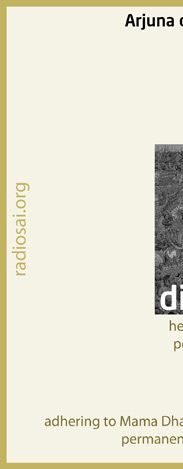 |
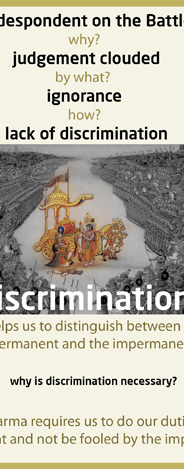 |
 |
And now a few general remarks about this Chapter, after which I shall take you through a rapid tour of it. Here are the points:
- The crisis or moral dilemma that Arjuna faced related to action. What exactly should he do, confronted as he was with two options, both of which appeared to have their own merits?
- Arjuna’s dilemma illustrates the problem of making a choice when confronted with difficult options; this is sometimes called Dharma Sankhatam.
- In life, we frequently have to make a choice amongst many alternatives. For example, while dressing to go to work, you may wonder which shirt to wear; there are many possibilities and you have to make a choice. Fortunately, questions of Dharma do not enter here. However, you may be confronted with a situation where you may be called upon to pay a bribe to get a certain thing done. Should you simply pay up and get the job done quickly or not pay the bribe? If you do not pay bribe or speed money you might have to wait for eternity. Is that OK? Should one just wait forever, for Dharma to work?
- Whenever there is a choice related to purchase, job selection, etc., the normal procedure followed is one of critical analysis, then evaluation and finally making a firm decision. At the root of it all is discrimination.
- Everyone must have the ability to discriminate and make the proper choice, be it in relation to family matters, business, or nation building.
- However, when it comes to matters of ethics and morality, often the choices are not so easy to make. What should one do? How exactly should one proceed? How does one build up this faculty of proper discrimination? What happens if one fails to do that?
Krishna Instructions on How to Discriminate
That is the lesson that
Krishna teaches Arjuna, after creating first a situation in which Arjuna
finds himself confronted by a moral dilemma. People often imagine that Krishna told Arjuna to get up and fight and that really is what the Bhagavad Gita is all about. This is not correct. Krishna talked to Arjuna not so much about fighting but about doing one’s duty properly. Krishna goes about this in the Second Chapter in the following manner:
- First, Krishna asks Arjuna to make a clear distinction between that which is permanent and that which is temporary. In modern parlance, one could loosely interpret that as making a distinction between the long-term and the short-term aspects of the problem.
- Krishna then says that life is a sequence of actions, and before performing any action, we must be careful to make sure it is a proper action. As a first step, one must learn to identify the short and long-term implications.
- Having identified the two main sorting bins comes now the problem of making a proper choice. For this, says Krishna, one needs discrimination, Spiritual Discrimination to be more precise. The word Krishna uses is Buddhi.
- How does one bring Buddhi into play? Buddhi would not start functioning just like that. To get it started, one must prepare the ground.
- That means one must first practice some internal discipline via sense and mind control.
- Only a person that has his senses and mind under control can think calmly and make a detached judgement.
 |
 |
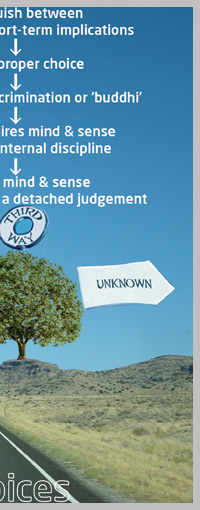 |
In other words, the Second
Chapter is all about proper action, how engaging in right action
requires first identifying clearly the options, and then discriminating
wisely. The latter would not be possible, unless one practices a certain
amount self-discipline via sense and mind control.
Let us quickly see how all
this is relevant in the case of Arjuna’s problem. Arjuna did not know
whether he should fight as he had earlier sworn he would. The question
thus was: “What was the path of action he must pursue, to fight or not
to fight?”
To help him to decide,
Arjuna tries to analyse the consequences of the two options in terms of
death, destruction, etc. This, Krishna says is a mistake. He says one
must first distinguish between the permanent and the impermanent. Thus
it is that Krishna says, “Arjuna, you are doing the analysis in terms
of the body, that is, in terms of death and life. This is wrong. Make
the Atma the basis of your question and analysis, and not the body.”
After this comes a
definition of proper action, discrimination, etc. So that is the way we
must try and follow the sequence of the ideas. When we do that, we would
realise that one way or the other, everything that Krishna says in the Gita relates to Mama Dharma.
Let us get back to the
basic question: “How do I perform my duty?” The simple answer is:
“Always perform the right action.” However, knowing what exactly is the
right action is a bit tricky, and that is where the Second Chapter
offers an incomparable tutorial.
The Atma is Beyond Birth, Death and Change
After that long preamble, may be we should get started. Let me begin by quoting some of the slokas relating to the Atma. This is what Krishna tells Arjuna:
- The Blessed Lord said: “Thou mournest for them thou shouldst not mourn, and utterest vain words of wisdom. The Wise sorrow neither for the living nor the dead. [2.11]
- For never was I not, nor thou, nor these kings; nor will any of us cease to be hereafter. [2.12]
- As the embodied One [Atman] successively experiences in the present body infancy, youth and old-age, even so He does when passing on to another body. [2.13]
- The Atman is neither born nor does it die; nor once having been will it ever cease to be. Unborn, Eternal, Ancient, It is not destroyed when the body is slain. [2.20]
- As a man casts off worn-out garment and acquires others that are new, even so the Indweller casts off worn-out bodies and enters others that are new. [2.22]
- Weapons cannot cut It, nor can fire burn It; water cannot wet It nor can wind dry It. [2.23]
So much for a few
invaluable tips about our true nature. Incidentally, we all have heard
Swami often raise the question 'WHO AM I?' in many of His Discourses.
The next time you hear that, please let your mind go back to the above
verses, which contain the answer.
The answer is: “I may have a
body that carries a name given to me by my parents. That is the name by
which the world might know me. However, that is not the real me; the real me is the Atma within.”
 |
 |
 |
The Best Way to Perform Actions
The next point; what about the right action or the right duty? In this context, the following sloka becomes very important.
Action alone is thy province and not the fruits thereof. Seek not the fruits of action nor shouldst thou avoid action. [2.47]
This is an oft-quoted sloka and heavily interpreted too, but we shall try and take a look at it in the context of Mama Dharma. It says effectively: “O man! Your actions, whatever they are, fail to qualify to come under the category Mama Dharma
if the action is performed with a selfish motive. The lower-self is
given to attachment and selfishness, and actions performed to gratify
the lower-self in one way or the other means that importance has been
given to the body, which is impermanent rather than to the Atma,
which is permanent. In short, avoid actions related to self-advantage.
Instead, focus on selfless actions, because they are always rooted in
and flow from your true nature, the Atma.”
We often talk about how
selfless Swami’s actions invariably are. That is so, because all actions
of all Avatars on all occasions always reflect the true nature of the
Avatar, namely the Divinity that the Avatar personifies.
This brings us to matter of making the right choice, which is where Buddhi enters the picture. The following are some of the slokas related to the exercise of Buddhi while discriminating properly and making the right choice where action is concerned.
- Act thou O Dhananjaya, renouncing attachments, even-minded in success and failure; verily, equilibrium is Yoga. [2.48]
- For motivated action, O Dhananjaya, is far inferior to desireless action; seek thou refuge in equanimity. Wretched are the result seekers. [2.49]
The key words in the above slokas
are: attachment and equanimity. Let us pause a bit and try to
understand what they imply. Attachment is a characteristic of the
body-mind combination that is a part of the human personality. The
senses, colluding with the mind, make a person go after the attractions
of the world.
The question arises: “Why
do people develop attachments and desires, which the Lord says are not
good for man?” This needs a bit of examination. In brief, there are six
evil tendencies that humans can be corrupted by. They are Kama, Krodha, Lobha, Moha, Mada and Matsarya (lust,
anger, greed, attachment, pride and jealousy). Swami has cited them so
many times that I really do not have to add a detailed explanation of
these six deadly enemies. These are the six traditional deadly snakes
luring inside and waiting to strike. Swami adds two more to the list;
they are, ahamkaram and mamakaram, meaning, ego and pride arising out a sense of ‘mine’, which also leads to a kind of possessiveness.
 |
 |
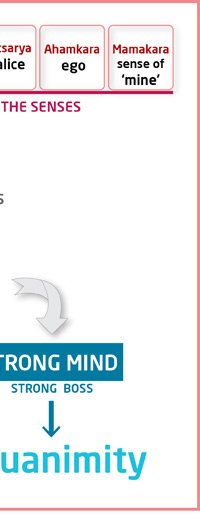 |
Krishna tells Arjuna that
all these snakes hide in the crevices, nooks and corners of the mind.
How exactly do they operate and how come they are so successful in
trapping man? Swami has explained that beautifully. Basically they drag
the senses to the outer world, which is full of “attractions”, like
gambling, for example. The senses then tempt the mind, which if it
succumbs, then leads the body on the wrong path and makes it perform
incorrect actions.
This being a crucial point, let me go over it slowly and once more. The vices kama, krodha,
etc., are like agents or touts. They try to sell various worldly
attractions to the senses. The senses which report to the mind –
remember, the mind is the boss of the senses – try to make the mind get
hooked on to the pleasures and attractions of the world, like gambling,
drinking, and so on. Bosses are of two kinds, weak and tough. If the
mind acts like a weak boss, it follows the senses into outer world along
the treacherous paths sold by the touts to the senses. Then follows
disaster.
People ask: “Does that mean
that senses are bad? In that case, why did God endow man with senses?
Is God not being very unfair?” A valid doubt, but at the same time it is
the result of superficial thinking. God has endowed not only man but
also animals with senses. They too can smell, hear, see, etc. God has endowed living being with senses for survival and protection against dangers in the external world.
For example, when a tiger
feels thirsty, it can, thanks to its eyes look for water. Similarly,
when a deer hears suspicious noises in its neighbourhood, it suspects
the presence of tiger nearby. In fact, many animals have very sensitive
capacity for smell and can literally smell danger. Thus thanks to the
senses, animals can protect themselves against peril. Man too needs similar protection, which is why the compassionate God has given him five senses. The problem is that man misuses
the senses for getting attracted to the pleasures of the world. He is
not supposed to do that but he does, and that is the starting point of
all problems.
The Mind and the Senses Silently Cloud One's Discrimination
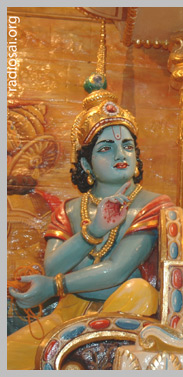 |
 |
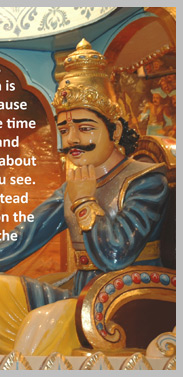 |
May be you think I have
strayed far from Arjuna and his moral dilemma; not at all. Let us start
from the beginning. Arjuna did not want to fight. That was because he
was confusing wrong for right and right for wrong. Why did Arjuna’s
thinking process stray like this? Because his mind was weak. Why was his
mind weak? Because it had been corrupted by attachment. Wherefrom does
attachment arise? It arises when one immerses oneself too much in the
external world. Swami describes Arjuna’s problem beautifully. He says:
“Arjuna, know that
all the people you are so concerned about are only chariots. They may be
grandfathers, or brothers, or cousins; whosever they may be, they are
all only chariots.
Your vision is
clouded because you are all the time looking at and thinking only about
the bodies you see. You must instead concentrate on the Indweller who is
seated in every body. Then only would your vision become sacred.
The unchanging
object is the Atma, whereas the external beauties of the bodies and all
the thoughts, feelings and behaviours exhibited by these bodies are just
images. They are only shadows without real substance.
At present, you are
still living with so many attachments. When you are so bound up, how
can you develop equanimity? Recognise the Truth which is permanent;
attach yourself to Divinity.”
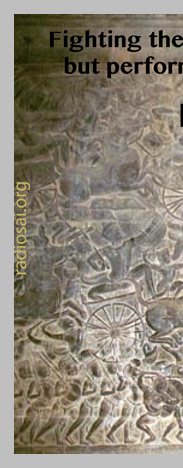 |
 |
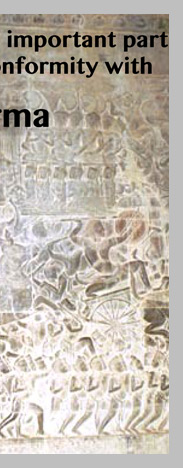 |
In the Gita, the
words that Krishna uses are: Dwelling with the mind on sense objects
develops attachments. And as Swami points out, attachments can cloud
judgement. So you see, the Lord is not merely giving a command to Arjuna
to get up and fight. If all that Krishna wanted was Arjuna to get up
and fight, He could have just used a stern tone and commanded him to do
so. Yes, Krishna did want Arjuna to fight. However, fighting was not the important part but performing action that was in conformity with Mama Dharma.
Krishna being the perfect
Teacher, knows how to coax His student. He does this by explaining in
full the reason behind His advice. And Krishna does it for a more
important reason which is that He wanted the Gita to become the manual of life that would guide all humans at all times along the path of Dharma, so that they can eventually become one with God.
I am sure it must have been
a heavy dose and so I shall stop here. Next time, I shall continue from
where I have left off in this article. I still have a few more things
to say about the teachings of the Lord in the Second Chapter. Let me
remind you once more that my focus is always on Mama Dharma that Swami says is the essence of the Gita.
If you have followed closely what I have discussed in this piece, you
would appreciate that Krishna presents His teachings with detailed
explanations so that we can clearly understand how they are relevant for
all times for all people, no matter where they are.
Thank you. Jai Sai Ram.
MUSINGS ON THE GITA – 03
by Prof. G. Venkataraman
The Bhagawad Gita was delivered by Lord Krishna to the warrior prince Arjuna on the battlefield of Kurukshetra as an antidote to the dilemma that arose in him. It was not a choice between right and wrong, rather it was dilemma between the 'apparently' right and 'absolutely' right. Five thousand-odd years later the wisdom of the Gita is still not lost in context in modern times. In fact it is more relevant and needed now than ever.
Presently we bring you this musing series by Prof. G. Venkataraman which is on the 'Essence of the Gita'. In this modern age of rationalism we tend to refuse to accept anything that is not offered on the platter of scientific approach. And that is what makes this presentation by an eminent scientist a work of unquestionable relevance. He has infact authored a comprehensive book on the Gita: Conversation Between God and Man, which is popular as much for its profundity as its lucid and simple-to-understand conversational style.
The current series of articles is actually an adaptation of a radio series that was produced and aired on Radio Sai on the request of our listeners. In these episodes too Prof. G. Venkataraman has dealt with the teachings of the Gita in a practical, scientific and thematic manner which makes for interesting reading and easy understanding.
Loving Sai Ram and
greetings once again from Prasanthi Nilayam. It is truly a wonderful
feeling and a blessing at the same time, to bring to you the essence of
the Message of the Lord, which is 'Mama Dharma'. This is a word that ought to rule our lives; yet almost everyone on earth is ignorant about it.
The Lord came down earlier as Krishna and now again in the physical form of our beloved Swami, simply to remind us to follow Mama Dharma and
never deviate from it. Nevertheless, we are hardly aware of what it is,
which is why Radio Sai has decided to offer this series. We hope you
like and are able to understand what we are trying to convey. With that
introductory note, let me resume from where I left off last time.
Making the Right Choice – The Essence of Sankhya Yoga
In the previous episode, I had started with you on my tour of the Second Chapter of the Gita, entitled Sankhya Yoga, meaning the 'Yoga of Discrimination and Wisdom'. Just to recap, Arjuna who had earlier decided to fight for the cause of Dharma, was, at the last minute, trying to quit. Fighting for Dharma is not easy and most of us tend to chicken out when the price seems to be high.
It is because most of us abandon Mama Dharma
for some reason or the other, that the world today is beset with all
kinds of problems. And finding ourselves in a huge mess, we ask stupid
questions like: “Why did God create this world with all these problems?
Why does not God appear and sweep away all these problems with His
Divine powers?” Not for a moment do we say: “This is a mess we created,
and that is because we systematically chose to ignore the lessons so
mercifully given by the Lord not only via sages and prophets, but also
during His personal appearances on earth as an Avatar.”
Since it is a mess that
we have created, it is evident that it is we who must clean it up; we
simply cannot pass the buck and ask God to sweep the chaos that is our
making; that would be like adding insult to injury! Man going astray is
nothing new, and that is why way back, Lord Krishna told Arjuna where he
was going wrong and what he had to do by way of mid-course correction,
especially in terms of making the right choice. Making the right choice is what the Second Chapter called the Yoga of Discrimination and Wisdom is all about.
 |
 |
 |
 |
 |
 |
 |
 |
Let me now quickly recall the important points I made last time, before we proceed further. I said the following:
Arjuna was confused about
what exactly his duty was. He had two options before him and reasoning
in a particular way, he thought it was best for him not to fight. He
conveyed his anxiety and doubts to Krishna and sought refuge in Him.
 |
The Lord began by chiding Arjuna and then told him that he was making a wrong choice.
Krishna added that the wrong choice was the result of Arjuna not being able to discriminate properly.
Krishna added that the wrong choice was the result of Arjuna not being able to discriminate properly.
The Lord then pointed out that discrimination would fail when there is attachment.
The Sinister Malady of Attachment
The question now becomes: “How does this attachment arise?” Krishna has the answer in the following Sloka:
Dwelling the Mind on sense objects develops attachments. Attachment leads to desire and desire breeds anger. [2.62]
Krishna continues:
From anger rises
delusion; delusion promotes confusion of the Mind; confusion generates
loss of reason; and finally, loss of reason leads to complete ruin.
[2.63]
He attains peace who conquering desires lives without the feeling “I” or “mine”. [2.71]
It is important to spend
some time digesting the above observations of the Lord. Let me start
with attachment. Attachment is a feeling entirely connected with this
world. We get attached to things we like and to people we like. Among
other things, Arjuna was attached to his grandfather, his Guru and his
relatives. One might argue, that is but natural. Yes, in a purely
worldly sense, attachment is perfectly natural and is to be expected.
However, attachment has its dangers; in particular, it can cloud one’s
judgement.
Let me give some examples
of how attachment can and does cloud judgement. Take the case of the
blind King Dhritarashtra. He was so attached to his sons, that he
invariably overlooked their faults. That was then, and it happens to be
so even now. How frequently we hear of political leaders who are blind
to the faults of their family members who exploit the position of the
leader concerned.
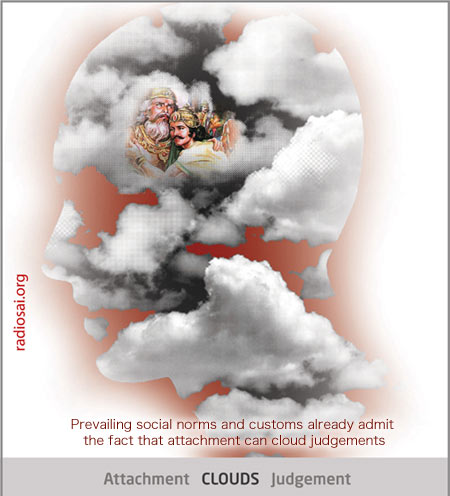 |
Consider next a surgeon
whose child is very sick and has to be operated upon. Medical ethics
require that the surgeon should not perform the operation. Why? Because,
his attachment may make him lose his cool, as result of which, he could
make serious mistakes.
In the judicial world, a
judge cannot preside when one of his relatives appears before the court
in a case, especially a criminal one. Similarly, a teacher cannot set a
question paper for a public examination for which his son or close
relative is appearing. This would be a case of conflict of interests.
What I am trying to say is that prevailing social norms and customs
already admit the fact that attachment can cloud judgements. That is
what the Lord pointed out thousands of years ago, and in a larger as
well as deeper context. The point is simple; attachment springs from body consciousness and leads to wrong conclusions and decision-making.
In general, attachment arises from giving importance to the transient, while ignoring the permanent. Thus far, I have considered the immediate consequences of attachment; in the Gita, Krishna takes us much further.
He reminds us that
attachment can plunge one into disaster. That precisely is what happened
in the case of the Kauravas. You will recall that the Kauravas were
greedy and jealous. That clouded their judgement and prevented them from
seeing the difference between the transient and the permanent. Net
result:
1) They did everything possible to dispossess the Pandavas.
2) That in turn led to the war.
Finally, they all perished because the end and the means were both wrong.
2) That in turn led to the war.
Finally, they all perished because the end and the means were both wrong.
Dealing with Attachment – The Right Way
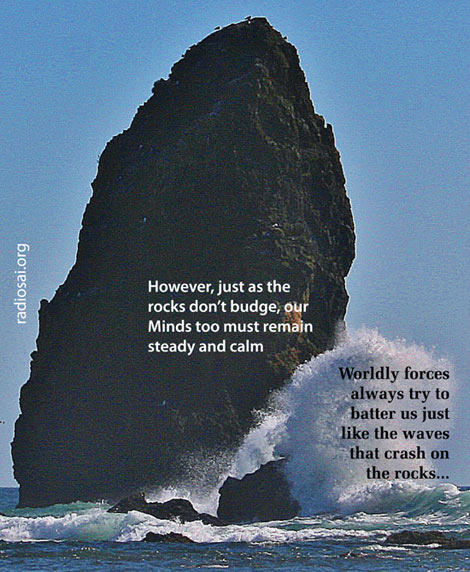 |
As I said earlier, since
we are all worldly creatures, attachment is to some extent inevitable.
However, we must at least strive to keep it to a minimum, and at crucial
moments keep it at bay, so that our judgement can be clear. In short,
we must learn to be calm.
Being calm, cool-headed
and having an attitude of equanimity is no doubt a virtue in management
circles. Equanimity is a must for worldly leaders also, so that they can
think calmly when confronted with crises and disasters. In the
Spiritual world too it is vital, because, as Krishna says, it helps one
to withstand the ups and downs of life. Swami tells us that worldly
forces would always try to batter us, even as powerful waves crash on
the rocks on seashores. However, just as the rocks don’t budge, our
Minds too must remain steady and calm. This comes via sense and Mind
control that Swami reminds us about, so often.
In the Gita, Krishna
gives the first introduction to that topic in Chapter 2; the theme is
elaborated upon later. So what does Krishna have to say about
equanimity? This is what He declares:
Endowed with
equanimity, one frees oneself in this life from good and evil alike;
therefore devote thyself to Yoga; verily, work done to perfection is Yoga. [2.50]
Please note what Krishna says about doing whatever it is that we do, to perfection. God is perfection, and He loves to see perfection in our work.
I would at this point, also like to quote a Sufi poem that beautifully describes the attitude of a perfectly detached person.
At night prisoners forget their prison,
At night kings forge their power,
No sorrow, no brooding over gain and loss,
No thought of this person or that,
This is the state of the Liberated person,
Even when he is awake.
At night kings forge their power,
No sorrow, no brooding over gain and loss,
No thought of this person or that,
This is the state of the Liberated person,
Even when he is awake.
Notice the word
‘liberated’ that occurs in this poem. This word conveys the idea that a
person who is always calm and unruffled, is free from mental
disturbances that the ups and downs of life can cause. By the way,
Krishna describes such a person as Sthithaprajna. Elaborating further, Krishna says:
What is night for all beings
is for the enlightened one day; and that which is day for others is to
him who dwells in the Self, night. [2.69]
 |
 |
 |
 |
 |
 |
 |
 |
Krishna refers to the Sthithaprajna
as the enlightened one. Why? Because such a one is able to clearly
distinguish the difference between that which is permanent and that,
which is temporary. Having understood the difference, such a person
immerses himself in the contemplation of the Inner Self or the Atma, and
is least bothered about the tornadoes of life. It is to highlight this
difference that Krishna says that what is night for others is day for
him and so on.
Commenting on this, Swami says that people misunderstand this to mean that he who is awake at night when the world sleeps is a Sthithaprajna. Swami adds that if that were true, then all night watchmen would qualify to be Sthithaprajnas! That is not what Krishna meant. What
the Lord meant was that what ordinary people thought was real was to
him unreal, while what people took to be unreal was in fact real. I hope that is clear.
At this point, I am sure
many would be ready to quit saying that what Krishna asks for is most
unrealistic. How can one deliver the moon, all of us would tend to ask?
In fact, at one point, Arjuna Himself raises this issue, and Krishna
answers the query. We shall come to all that later but here I would like
to say that with discipline, such a control CAN be achieved. It is just
that we are not prepared to pay the price for achieving
self-discipline.
This is not to say that
people would not go to great extent to attain worldly ambitions. Just
look at the number of people who are ready to die just to become movie
stars or sports stars or politicians, and so on. Some people go the
extent of doing absolutely crazy things just to get into the Guinness
Book of Records. There are people who take great delight in growing
fingernails that are one meter long, beards that are two meters long,
and so on. They go to enormous extent to spend a month or so in a glass
cage in the company of hundreds of scorpions, etc. In other words, if
people really want, they can do very difficult things.
 |
So
it all boils down to will power. While many exert themselves to achieve
all sorts of worldly ambitions, when it comes to mental discipline for
achieving Spiritual goals, then suddenly it all becomes so very
difficult and impossible. Swami says, as you are so you become.
If you want to be acknowledged as a great one in the world, you would
become great by much effort. Similarly, if you want to be really good,
you can achieve that goal also through much effort. It is just that most
people do not want to do the latter, dismissing that objective as
worthless.
People often yearn for
peace. However few realise that peace which really means mental calm,
will not drop like manna from heaven. It comes only through a systematic
effort to cultivate detachment. And when one is able to become
detached, one would really enjoy great inner peace. Commenting on this,
Krishna says:
He attains peace who conquering desires lives without the feeling “I” or “mine”. [2.71]
Highlights of the Second Chapter of the Gita
I think I should start
wrapping up this talk by summarising for you what the Second Chapter is
all about. This is the chapter where Arjuna surrenders to Krishna and
seeks the Lord’s guidance. In the Gita Vahini, Swami describes this
scene as follows:
Arjuna, there are many
reasons for your sorrow but the most fundamental one is your ignorance.
Unaware of your true nature, you have been overwhelmed with grief. But
now you have cried out for God and Dharma. The moment you cry out for God, it becomes Yoga. When you cry for Me, I will take care of you and give you everything you need.
Arjuna says that he would
not fight because people would be killed. Swami points out that it is
not killing that makes Arjuna have doubts. As a warrior, he had earlier
killed many in battle. What made him have doubts now is the fact that
the people who might now die would be his blood relatives. In other
words, the feeling of ‘mine’ was beginning to dominate in him. That and
not killing per se, was the source of his doubts. Recognising this,
Krishna tells Arjuna that his problem was in not being able to
distinguish properly between the real and the unreal, between the
transient and the permanent, between Truth and untruth.
Krishna then points out that the only thing eternal is the all-pervading Atma. The people we see around us, indeed all-living creatures are nothing but the embodiments of the Atma. When a person dies, only the external casing called the body dies while the Atma within remains intact. That is not surprising since being Divine and Eternal, the Atma
is beyond all destruction by the most powerful of worldly forces.
Krishna tells Arjuna not to be a fool and weep for that, which is
eternal.
Krishna follows this up by explaining to Arjuna why he is so confused; it was all because his Buddhi (intellect) had become blunt. When Buddhi fails to operate, one gets drowned in Spiritual ignorance, no matter how smart one might be on the worldly plane. That precisely was what had happened to Arjuna.
So the question now
becomes: “How to get rid of Spiritual ignorance?” Krishna tells Arjuna,
for that to happen, a prerequisite is equanimity. How does one achieve
equanimity? Well, for that one has to practice sense and Mind control.
Tough it might be, it is not so tough if one who perseveres is
disciplined and cultivates patience. Remember
Swami telling us about the three P’s - patience, perseverance and
purity? That advice was first given by Him to Arjuna five thousand years
ago.
 |
 |
 |
 |
 |
 |
 |
 |
So in reverse order, we
must first try to become pure through perseverance. We would then
achieve equanimity. In turn, that would enable us to discriminate
properly and make all the right choices when it comes to right action.
And in a sense, right action is really what Mama Dharma is all about.
Are We Practising Mama Dharma?
All this becomes pretty
obvious when explained but not so obvious when we read about it in the
Gita. I am able to explain in simple terms because Swami has done it
earlier in so many different ways on several occasions. Let us take a
minute off to thank Swami for that. These days modern man imagines
himself to be damn smart just because he has invented TV, Internet, the
mobile phone and what not. Yes, the Medha Shakti
or the worldly intelligence of modern man has enabled him to split the
atom and tinker with the genome but, as Swami says, of what use is all
that when man cannot recognise God walking on earth?
I must not omit to point out the importance of the following Sloka, to which I have made reference earlier.
Action alone is thy province and not the fruits thereof. Seek not the fruits of action nor shouldst thou avoid action. [2.47]
This Sloka which is often cited as the basis of Karma Yoga, is also the gene of Mama Dharma.
I shall have more to say about this later in the next episode, when I
shall be discussing the Third and the Fourth Chapters. But here I would
like to mention the following:
Normally, when we do
something, we generally tend to ask, “What’s there in it for me?” Such a
question is born of selfishness and self-interest. For example, these
days, everybody complains heavily about adharma, corruption and
what not. But who lifts his little finger to do anything about? If the
question were to be raised, people would shrug and say, “Be practical.
Corruption cannot be fought by a small person like me.” That is another
way of saying, “Why should I struggle to fight corruption? It is a
thankless job. What is there in it for me?”
This is the standard way of ducking the difficult job of protecting Dharma. Arjuna too was running away from his job of protecting Dharma,
though he was not quite aware of it. Krishna shocked him by drawing
attention to things that matter more than the transient affairs, to
which we normally give so much importance. So you see, one way or the
other, it all boils down to Mama Dharma. The roots of Mama Dharma may be in the Spiritual world, but its trunk and branches are in the real practical world.
A few final thoughts about the Second Chapter. Swami says:
The Second
Chapter is an extremely important part of the Gita… You have to take
this Chapter stanza by stanza and spend, if need be, two to three days
on concentration, trying to understand… Each word of each verse in this
Chapter can be considered a rare jewel. It is only when you can
completely understand the nature of Sankhya Yoga that you would be able to understand the Gita in full.
One more remark. We all know that Gandhi drank constantly and deep from the Gita. Concerning this, Swami says:
Mahatma Gandhi used to read the Sankhya Yoga twice or thrice, whenever his Mind was restless and perturbed. It restored his peace of mind. The Sankhya Yoga is the life of the Gita.
 |
 |
 |
 |
 |
 |
 |
 |
So you see, the Sankhya Yoga
teaches us how equanimity would help us to overcome mental
restlessness. These days, it is fashionable for people in the Corporate
sector to go in search of Gurus who teach meditation and so on. All this
is nice up to a point. But the real basis for all this is the Sankhya Yoga. I do not know how much Corporate managers of today would like to hear about Sankhya Yoga.
Modern managers might not be interested but Krishna made sure He devoted an entire chapter on Yoga of Meditation. That would come later.
In summary, what I have tried to stress today is the importance of detachment and equanimity in sticking to Mama Dharma.
The question might be
asked: “How it is possible to be so detached and yet so active in this
practical world which is so full of all kinds of distracting forces?”
This is an important question that we shall consider later. But here I
would like to say that interestingly, the answer was given in the famous
Yoga Vasishtam, taught by Sage Vasishta to Lord Rama much earlier.
I hope I have not lost you! Please do write back your reactions and comments to the usual address – h2h@radiosai.org
Thank you and Jai Sai Ram.
TEXTO TOMADO DE: http://media.radiosai.org/journals/vol_09/01SEPT11/03-gita_01.htm


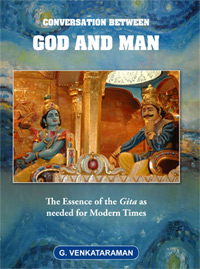






















No hay comentarios :
Publicar un comentario